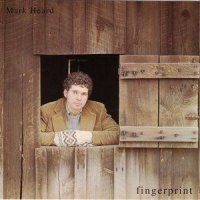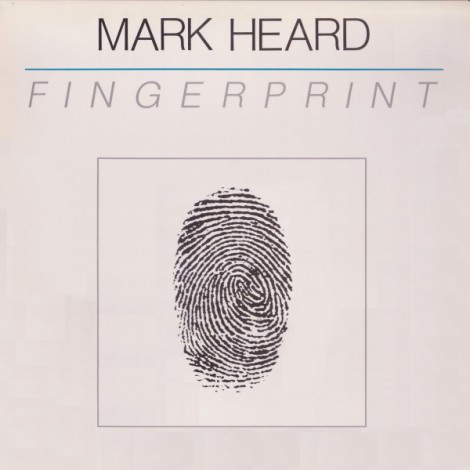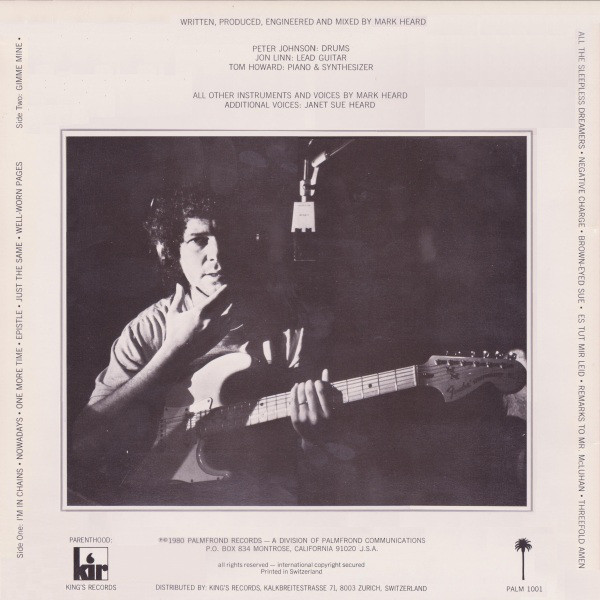
The story goes that in 1980 Mark was having difficulties with Larry Norman and Solid Rock Records. As he was on contract in the USA he went to Europe to record and release this album. However there is a secondary story that is much simpler and in my opinion more possible. It is that Mark was essentially living in Europe and as such chose to release his next album there. The album was originally released on his own label in Switzerland which is a relatively odd business decision. All that aside this album was missed by most Mark Heard fans as it wasn’t released in the US until 1995. By now he was free and clear of Larry and Solid Rock Records so he released it on VIA Records. The album is about three quarters Mark’s signature acoustic guitar work but there are a few 70’s style rocking tunes. Mark rerecorded a few of these tracks between 1980 and 1995 to put on his North American releases so some of these versions may surprise you.
Tracklist
1 – I’m In Chains – 3:30
2 – Nowadays – 3:25
3 – One More Time – 3:03
4 – Epistle – 2:57
5 – Just The Same – 3:16
6 – Well-Worn Pages – 2:48
7 – Gimme Mine – 3:51
8 – All The Sleepless Dreamers – 3:33
9 – Negative Charge – 3:58
10 – Brown-Eyed Sue – 3:20
11 – Es Tut Mir Leid – 2:04
12 – Remarks To Mr. McLuhan – 2:02
13 – Threefold Amen – 0:20
Credits
Acoustic Guitar, Electric Guitar, Bass, Lead Guitar, Slide Guitar, Mandolin, Synthesizer [Moog], Percussion, Vocals, Backing Vocals – Mark Heard
Acoustic Guitar, Electric Guitar, Lead Vocals, Slide Guitar – Jon Linn
Backing Vocals, Photography By – Janet Sue Heard
Drums – Peter Johnson
Piano, Synthesizer – Tom Howard
Producer, Engineer, Mixed By, Written By, Photography By – Mark Heard
Companies, etc.
Distributed By – King’s Records
Recorded At – Peace In The Valley Recording
Phonographic Copyright (p) – Palmfrond Communications
Copyright (c) – Palmfrond Communications
Manufactured By – King’s Records
Pressed By – Turicaphon AG




The liner notes state it was a “homemade album” recorded at Peace in The Valley Studios, Los Angeles, California. This was a home studio owned by Terry Laughlin who is also acknowledged in the notes. The liner notes also thank three other contributing musicians for “dropping by” – probably an intentional mention to dispel any accusations that they were booked in advance through the musicians local.
The live song ‘Es Tut Mir Leid’ (Track 6 on side 2 of the vinyl LP) is a German language formal apology sung to an unnamed ‘Amerikaner’ in scathing satirical fashion. Heard sounds like he’s playing a pompous character in an opera buffa. It was recorded at a concert taping in Basel, Switzerland, June 14, 1980. It’s almost certainly aimed directly at Norman and the audience’s reaction seems to indicate they might be in on the joke.
The album was released and distributed in Europe.
Record contracts usually dictate where distribution is controlled under the contract (and by exclusion, where it is not), but are fuzzier about where and when studio recordings may or may not take place, and about who owns the recordings produced at sessions not sanctioned by the record company. Demos produced at no expense to the record company while the writer/artist is under contract are not always considered property of the record company unless the recordings are publicly released within the contract’s geographical jurisdiction or the songs pitched to and recorded by other artists releasing them within the contract’s jurisdiction during the term of the contract. Contacts often do cover where and when live performances can and can not be held and performers require approval from the record company for the artist to participate in compensated performances within the jurisdiction of the contract.
If Norman/SRR had been aware of the existence of the recording session(s) in L.A. they might have attempted to get a court order to take possession of the tapes before they left the U.S. [That’s exactly why some of Tom Petty’s master tapes were riding around L.A. for months in the trunk of a car belonging to a friend who Petty didn’t know exactly where he was at any given time. When he was testifying on the stand in the lawsuit with his record company he could say without perjuring himself that he did not know where they were located at that time.] This enlightens us as to why the liner notes went to very careful lengths to portray the recording session in L.A. in a way that did it not violate the terms of the contract with Norman/SRR.
I’m guessing Heard was spending a lot of time in Europe because he didn’t need Norman’s/SRR’s approval to perform concerts there without violating his contract with Norman/SRR. He probably couldn’t do the same in the U.S.
Wow some great info there and I love the Tom Petty story. I will add one point though. I have now spoken to a few SRR artists and only one of them had a contract (and none got paid from my small sample group either). The one who did have a contract pointed out to me that Larry breached it on the first album release. In the end I have changed my mind and now don’t think the rather odd release structure of this album had anything to do with Larry.
I don’t know, man. Side 2 in its entirety can almost be interpreted as a thinly disguised message to a hostile record company. In particular, Remarks to Mr. McLuhan (a/k/a Can You Hear Me), which immediately follows ‘Es Tut Mir Leid’, seems to be directed at someone at a record company. If only we knew who Mr. McLuhan was. (Hint: We do. He’s not a record company exec, but what he had to say and what he predicted about mass communication via decentralization of mass media is certainly something that has affected anyone in the music business. Dr. Herbert Marshall McLuhan (b.1911-d.1980) was a philosopher whose reputation peaked in the late 1960s but whose work had fallen out of favor and been all but forgotten by 1980 before making a “comeback” when much of what he predicted would happen in the future materialized with the emergence of the internet. [Did Heard suspect how Dr. McLuhan’s theories about the effects of what we now know as the internet would impact the music business and predict it would wreck the control record companies had over the music industry circa 1980?])
Imagine a situation where a record company refuses to create or release a particular project. “No one wants to hear that. You need to sound like *this* or *this*, not like *that*. We’re not going to let anyone hear you doing *that*.” The artist goes to Europe and releases the project.
“Can You Hear Me Now?”
What difference does it make
If this was once upon a time
You supply the stereo
And I’ll supply the rhymes
I’m aided by machinery
In hopes to reach your mind
Can you hear me
Can you hear me now
Just a needle scratching ridges
On this one-way plastic groove
My vinyl destination
My revolving imputation
I am singing and I’m playing
But my lips don’t have to move
Can you hear me
Can you hear me now
But just as loud and clear
You hear this song come through the air
It’s funny, but it’s as close as I can
To really being there
Frozen in this record
Are fingerprints and messages
Can you hear me
Can you hear me now